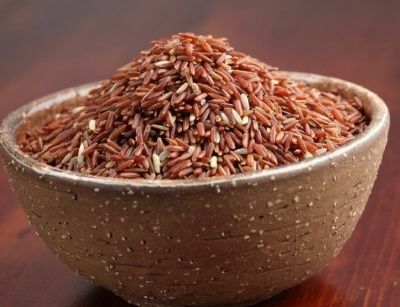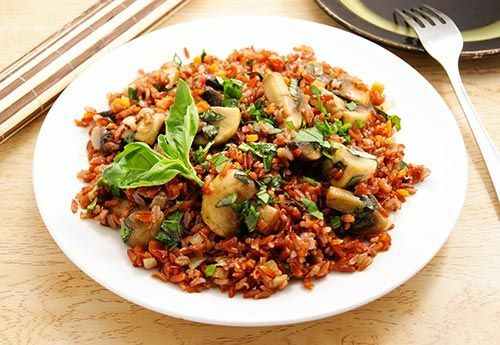Red rice has its unusual color due to the presence of natural plant pigment. And it was preserved due to the fact that this grain is not polished, that is, the shell is not removed. Like all red products, this rice is a powerful antioxidant, which allows it to protect cells of our body from internal and external toxic effects. But this is not the only positive quality of this culture.

In cooking red rice is very convenient, as after heat treatment it remains friable and it does not need to use any special technologies. Time of its preparation in comparison with usual white rice is a little more and makes about 35 minutes. This product is ideal for salads and side dishes.
Note! During cooking, red rice gives off its pigment and stains water. However, do not worry about the original color of the whole dish - it will not be particularly affected.
This cereal can be added to soups, it behaves well with stewed meat, vegetables and mushrooms. How does the red rice look, you can consider the following photo.

Composition and nutritional value of
This product is rich in vitamins of group B - B1, B2, B3 and B6.It contains mineral substances, including potassium, magnesium, calcium, iron, iodine and phosphorus. In addition, red rice is saturated with essential amino acids for the human body. And all these substances are very valuable and allow to work normally for all organs and systems.
Red rice is nutritious and incredibly useful. Its nutritional value per 100 g of product is:
- proteins - 75 g;
- carbohydrates - 68 g;
- fats - 3 g;The energy value of the
- is ~ 370 kCal.
In this case, the caloric content of red rice will vary depending on the method of preparation and can range from 330 to 410 kcal per 100 g.
The effect on the body
One of the German communities of adherents of proper nutrition recently published 10 basic rules on which to orient,to maintain good health and prolong the youth of the body. In the forefront are such canons - food should be varied, and the ration must necessarily be enriched with grain products, in particular - whole grains. A red rice is ideally suited to these rules. So, let's figure out what its benefits are and whether it can harm the body.
Useful properties of
Red rice contains an incredible benefit that was given to it by nature itself. And its value will be as follows:
- fiber maintains the normal composition of the intestinal microflora, improves digestion and helps to bring out cholesterol;
- red pigment is the prevention of the formation of atherosclerotic plaques;
 Red rice can be added to the list of products that will help reduce the likelihood of developing cancer diseases.
Red rice can be added to the list of products that will help reduce the likelihood of developing cancer diseases. - B vitamins monitor the condition of nails, skin and hair;
- minerals help our body not to lose, but only to multiply its protective functions and to resist a variety of diseases;
- magnesium eliminates migraines, improves overall condition with asthma, gives muscle tone, helps cope with stress, normalizes blood pressure and prevents the risk of heart attack;
- calcium helps magnesium strengthen bone tissue, and is also a prevention of osteoporosis and arthritis;
- potassium promotes removal of salts from joints, removes inflammation in them;
- iron prevents the development of anemia.
Important! Red rice unlike other cereals does not contain gluten, which is not included in the list of nutrients for our body.
Dishes from red rice turn out to be quite nutritious and most importantly, do not overload the intestines. Amino acids, which are part of this product, are similar to meat, and this allows you to partially replace meat with red rice.

Recommendation! Red rice, being unpolished, is ideal for people suffering from diabetes, because at the expense of a small glycemic index helps to normalize blood sugar.
Is there any harm?
As you can see, red rice has a huge number of useful properties. Are there any contraindications? What is most surprising, this product is completely deprived of them.
The main thing is to consume dishes from red rice in moderation, especially if you are just going to introduce it into your diet. Otherwise, it can cause flatulence.
